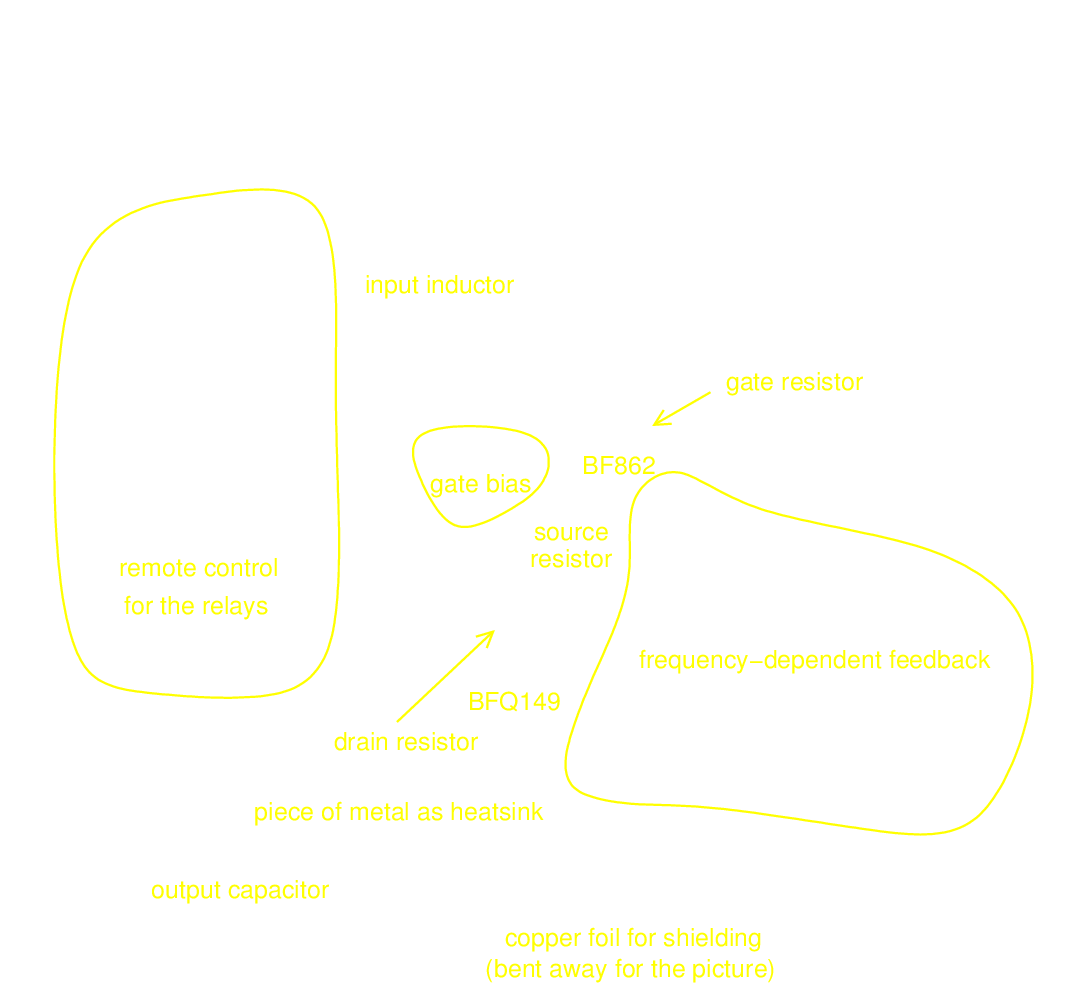Simple and better circuit for MiniWhip antennas
Pieter-Tjerk de Boer, PA3FWM web@pa3fwm.nlOn this page I propose a simple circuit for use in MiniWhip and similar e-field probe antennas. Since December 2017 a version of this circuit is in use at the Twente WebSDR receiver.
The circuit
The original PA0RDT MiniWhip is a very simple and effective active receive antenna for the longwave, medium wave and
shortwave range. It consists of a small metal plate and a buffer amplifier.
The amplifier has a very high input impedance (implemented using a JFET as a source follower)
to sense the voltage between the metal plate and ground, and a low output impedance
(implemented using an NPN transistor as an emitter follower) to drive the
50 ohm coax cable.
I've written more about how it works here and here.
PA0RDT's circuit can be easily found on the internet, as can various more complicated circuits
promising better intermodulation performance.
![[schematic]](miniwhip-pa3fwm.png)
On this page, I introduce an alternative circuit for this application which is simpler, yet has good (probably better) intermodulation performance. See the diagram for the circuit.
The new circuit has only the JFET source follower between input and output. Compared to the usual circuit, this avoids the emitter follower's contribution to the intermodulation. The output impedance of the JFET by itself is not low enough to drive a 50 ohm load (without lots of distortion). In the new circuit, this is solved by the PNP transistor: when the FET needs to supply some current into the load, this current also flows through the base of the PNP transistor, causing a proportionally larger (e.g., 50 times larger, if the transistor's hFE is 50) current to be supplied to the load. Effectively, the FET sees a 50 times higher load impedance.
For the FET, I prefer the BF862 because of its exceptionally low input noise.
Unfortunately, it is only available in SMD.
The non-SMD J310 (as used in most active e-field antenna designs) probably will work just as well in most situations,
but I haven't tried it.
[Update January 2018: I've tried a J310 in otherwise the same circuit, and found it gives somewhat more intermodulation: IP2 +60 dBm, IP3 +37 dBm.]
There aren't many PNP transistors which can both handle some power and work at high frequencies. One suitable transistor is the BFQ149, with an fT of 5 GHz, but unfortunately only available in SMD. An alternative is the non-SMD 2N5583, with an fT of 1.3 GHz. Those fT values may look ridiculously high for shortwave use, but at the fT the transistor's current gain has reduced to 1; the circuit stops working well at a much lower frequency. Possibly a plain 2N2905 or 2N2907 (fT=200 MHz) can also work acceptably well in some cases, but I haven't tried.
Measurements on various realizations of this circuit, using a BF862 for the FET and either a BFQ149 or 2N5583 for the
PNP transistor, gave OIP3 values between +40 and +43 dBm, and OIP2 around +70 dBm (tested with signals of 7 and 8 MHz).
I did not invent this JFET/PNP principle myself. I've seen such circuits in a few active antenna designs, but never with specifications of achieved intermodulation performance, and usually with a DC bias that seemed far from optimal for low intermodulation.
The new WebSDR antenna
![[miniwhip as built for the WebSDR]](miniwhip-pa3fwm.jpg) The above circuit forms the basis for the new antenna for the Twente WebSDR,
installed there on December 18, 2017.
See the pictures.
Compared to the basic circuit, there are a few notable differences:
The above circuit forms the basis for the new antenna for the Twente WebSDR,
installed there on December 18, 2017.
See the pictures.
Compared to the basic circuit, there are a few notable differences:
- Some passive components have been put between the collector and the source. Doing this allows the circuit to have some gain (it effectively acts as an amplifier with feedback), and even to make that gain depend on the frequency. In the WebSDR antenna, we make it 0 dB at low frequencies, and increase to 10 dB above a few MHz, with a dip back to 0 dB around 26.95 MHz, on which we have a very strong local pager transmitter. We need the gain because of our SDR board being somewhat insensitive, and the cable being long.
- There are two relays (the grey blocks) which can be remotely controlled (via the IC at the left). With these we can switch the input coil and the feedback circuit, which was useful for testing.
- There's quite some shielding, in the form of copper foil (bent down in the picture, but normally covering the circuit board). This was needed to prevent oscillations. Probably this wouldn't be needed with the basic no-gain circuit. A practical problem is that the collector of the PNP transistor is connected to its heatsink, so the entire heatsink is electrically "hot" and can easily capacitively couple to the antenna element.
- The actual antenna element is not a metal plate, as usual in MiniWhip antennas, but a bent thick copper wire. Since most of the charge on a metal plate sits at the edges (see here), it still works almost as well if only the edges are there, in the form of this wire. The wire looks like a coil of two turns, but it isn't: at the bottom, all wires are connected.
![[circuit board close-up]](miniwhip-pa3fwm-board.jpg)
